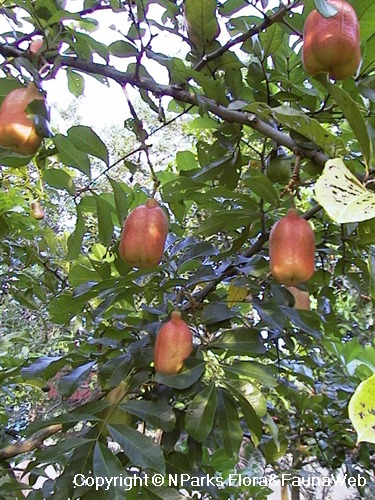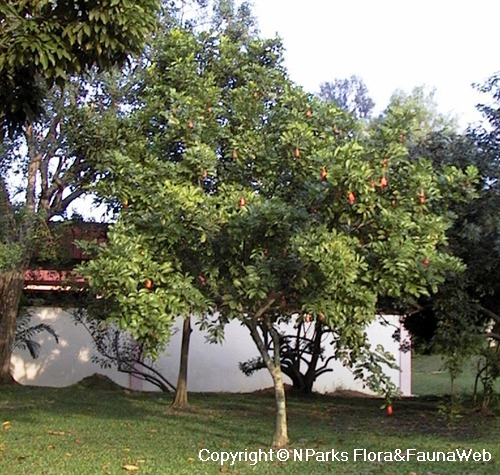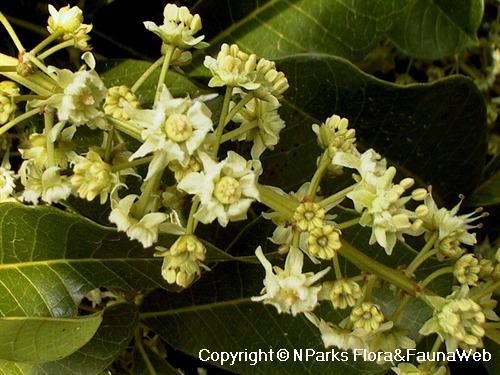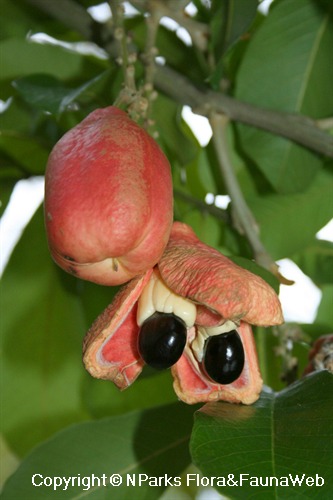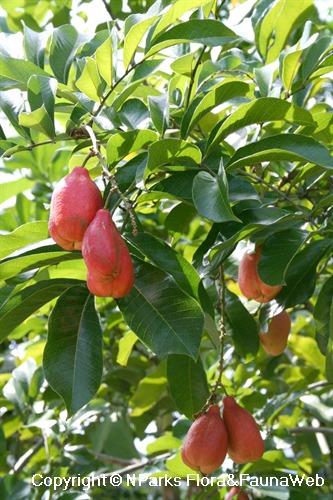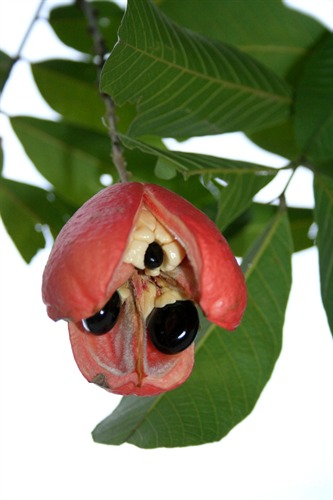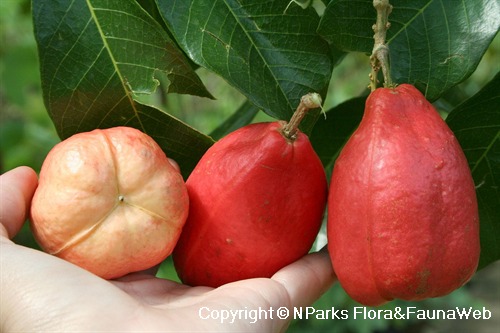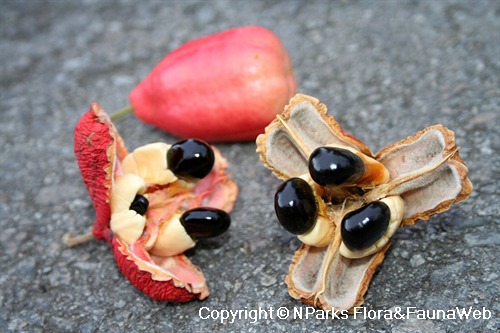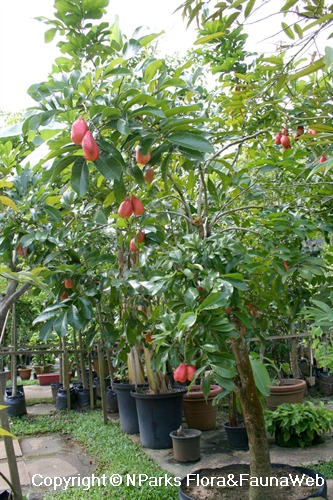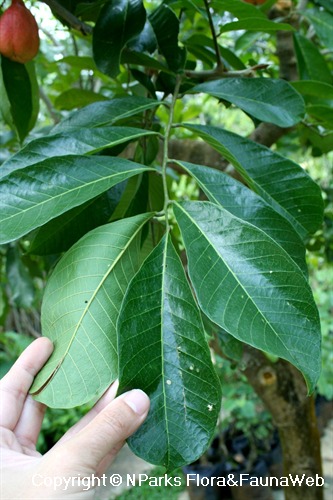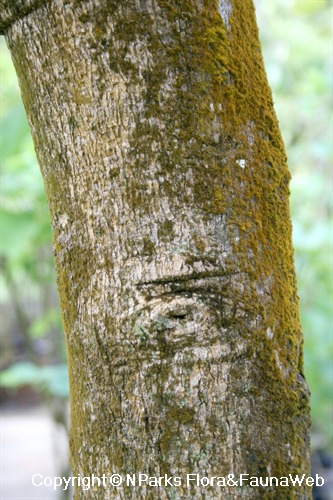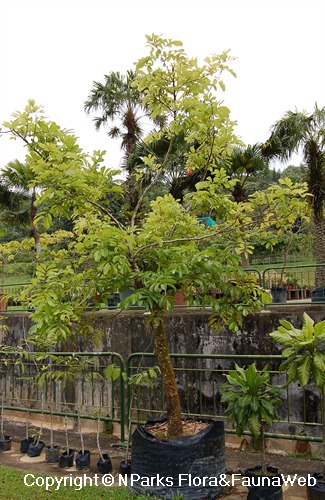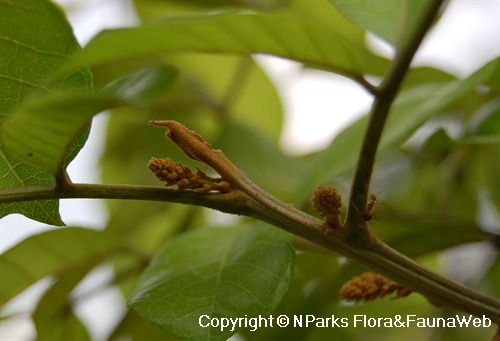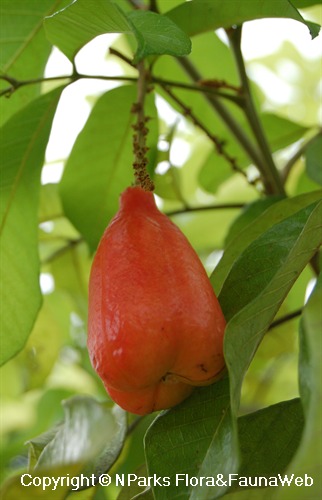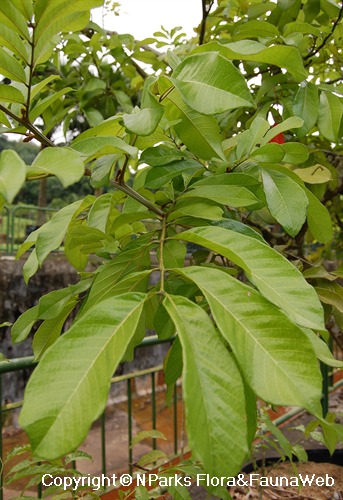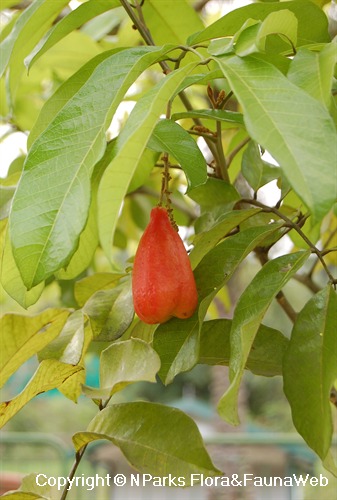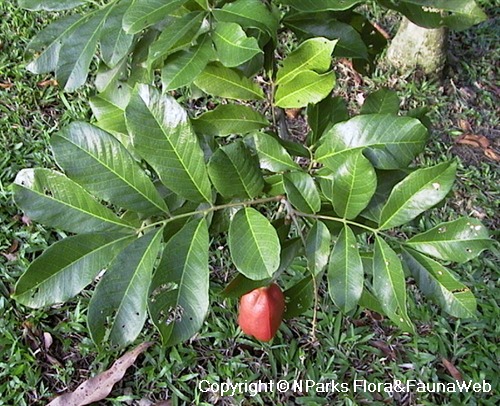
Back
Blighia sapida K. D. Koenig
| Family Name: | Sapindaceae |
| Synonyms: | Cupania sapida |
| Common Name: | Akee, Akee Apple, Seso Vegetal |
Name
Classifications and Characteristics
| Plant Division | Angiosperms (Flowering Seed Plants) (Dicotyledon) |
|---|---|
| Plant Growth Form | Tree (Medium (16m-30m), Small (6m-15m)) |
| Lifespan (in Singapore) | Perennial |
| Mode of Nutrition | Autotrophic |
| Plant Shape | Irregular |
| Maximum Height | 10 m to 18 m |
Biogeography
| Native Distribution | West Africa |
|---|---|
| Preferred Climate Zone | Tropical, Sub-Tropical / Monsoonal |
Description and Ethnobotany
| Others - Plant Morphology | Tree, 10-18m height. Related to Longan (Dimocarpus longan) and Lychee (Litchi chinensis). Compound leaves glossy green above, slightly furry and paler green below. Flowers greenish-white, fragrant, small, held in racemes, produced in bisexual and male forms.Fruits tri-lobed pear-shaped capsules, mature from green to scarlet-red in 7-8 weeks, splitting open to reveal 3 large shiny black seeds and fleshy creamy-yellow aril. Aril is edilble when fully ripe (ie. when fruits split open). Eaten with saltfish as national dish of Jamaica. Unripe aril and other parts of fruit toxic, causing possibly fatal toxic hypoglycemic syndrome.Prefers moist fertile loamy soils. Propagate by seeds, stem cuttings or grafting. Seedlings bear fruits in 4-5 years, while grafted plants produce fruits in 1-2 years. Genus Blighia named after Captain Wiliam Bligh (of 'Mutiny on the Bounty' fame), who saw the fruit in Jamaica and took it to England in 1793. |
|---|---|
| Ethnobotanical Uses | Edible Plant Parts : Edible Fruits Food (Herb or Spice) (Fruit or Vegetable) Others: Fully-ripe fresh aril is edible when fruits split open. Aril has nutty flavour and is eaten in Jamaica as part of national dish, or canned. Ripe aril consumed to lower fever and treat dysentery. Leaf sap used as eye drops to treat conjunctivitis. Crushed leaves used as poultice for skin ulcers. Immature fruits and seeds have high potash content, crushed to make foam and used as soap, or as fish poison. Durable and termite-resistant wood used in construction. Essential oils from flowers used as cologne. Seeds used to make beads. |
Landscaping Features
| Desirable Plant Features | Ornamental Fruits, Fragrant (Flowers) (Day) |
|---|---|
| Landscape Uses | Container Planting, General, Shade Providing Tree / Palm |
| Thematic Landscaping | Economic Garden, Naturalistic Garden |
| Usage Hazard - Cons | Toxic Upon Ingestion |
| Plant & Rootzone Preference or Tolerance Remarks | Tree prefers moist, fertile soils but tolerates limestone soils. |
Plant Care and Propagation
| Light Preference | Full Sun |
|---|---|
| Water Preference | Moderate Water |
| Plant Growth Rate | Moderate |
| Rootzone Tolerance | Fertile Loamy Soils, Alkaline high pH Soils |
| Maintenance Requirements | Moderate |
| Propagation Method | Seed, Stem Cutting, Grafting |
| Propagule Establishment Remarks | Trees grown from seed start to bear fruit in 4-5 years. Grafted trees produce fruits in 1-2 years. |
Foliar
| Foliage Retention | Evergreen |
|---|---|
| Mature Foliage Colour(s) | Green |
| Mature Foliage Texture(s) | Glossy / Shiny, Hairy / Hirsute, Raised / Sunken Veins |
| Foliar Type | Compound (Even-Pinnate) |
| Foliar Arrangement Along Stem | Alternate |
| Foliar Shape(s) | Non-Palm Foliage (Ovate, Obovate, Elliptical) |
| Foliar Venation | Pinnate / Net |
| Foliar Margin | Entire |
| Typical Foliar Area | Notophyll ( 20.25cm2 - 45 cm2 ) |
| Leaf Area Index (LAI) for Green Plot Ratio | 3.0 (Tree - Intermediate Canopy) |
Non - Foliar and Storage
| Trunk Type (Non Palm) | Woody |
|---|---|
| Bark Colour(s) | Gray |
| Mature Bark Texture | Smooth |
| Stem Type & Modification | Woody |
| Root Type | Underground (Tap Root, Fibrous Root) |
Floral (Angiosperm)
| Flower & Plant Sexuality | Bisexual Flowers , Monoecious |
| Flower Colour(s) | Green, White |
|---|
| Flower Size - Remarks | Small |
| Inflorescence Type | Raceme |
| Flowering Habit | Polycarpic |
Fruit, Seed and Spore
| Mature Fruit Colour(s) | Orange, Red |
|---|---|
| Fruit Classification | Simple Fruit |
| Fruit Type | Dehiscent Dry Fruit , Capsule |
Image Repository
Others
| Master ID | 1459 |
|---|---|
| Species ID | 2752 |
| Flora Disclaimer | The information in this website has been compiled from reliable sources, such as reference works on medicinal plants. It is not a substitute for medical advice or treatment and NParks does not purport to provide any medical advice. Readers should always consult his/her physician before using or consuming a plant for medicinal purposes. |

